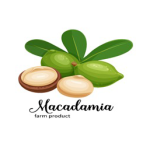THE MACADAMIA
About the Origin of Macadamia
Macadamia nut is a native of Queensland in the small town of Gympie and northern New South Wales of Australia; occurs along fringes of subtropical lowland rainforests. From historians, it is believed that the Aboriginal people used to occasionally congregate on the eastern slopes of Australia’s Great Dividing Range to crack and eat on the seed of two evergreen trees, one of which they called ‘Kindal Kindal’ which was the macadamia and they also had other names for macadamia including Boombera, Jindill & Baupal.
In the 1850’s these trees were noticed by a British botanist Ferdinand Von Meuller and Walter Hill, the Director of the Botanical Gardens of Brisbane, Australia. The two men were struck with the majestic beauty of the specimens found growing in the rain forests of Queensland. A distinction was made between Macadamia integrifolia (smooth shelled) and Macadamia tetraphylla (rough shelled) which also produces a nut that is edible, although not as good for roasting as Macadamia integrifolia. The genus Macadamia was named after a prominent scientist of that time, Dr John McAdam.
Growing Macadamias
Macadamia prefers well-drained soils, shelter from strong winds and a mild, frost-free, sub-
tropical climate with a well distributed annual rainfall of at least 1200 mm. Plantations from seed start protable bearing after 7 years, with productivity peaking after 15 years; the economic life of the tree being 50 years. At full production the yield is from 23 to 70 kg in-shell nuts per tree. Desirable clones have been developed by grafting. The species is cross pollinated, therefore desirable that at least two cultivars are grown in orchards, preferably in alternaterows. The presence of bees is encouraged for pollination (Rosengarten, 1984; Macrae et al., 1993). This is suitable for this farm in Mahenge whose rainfall is estimated at between 600-1200mm per annum. Natural waters however, make it viable to develop an irrigation system in the farm.
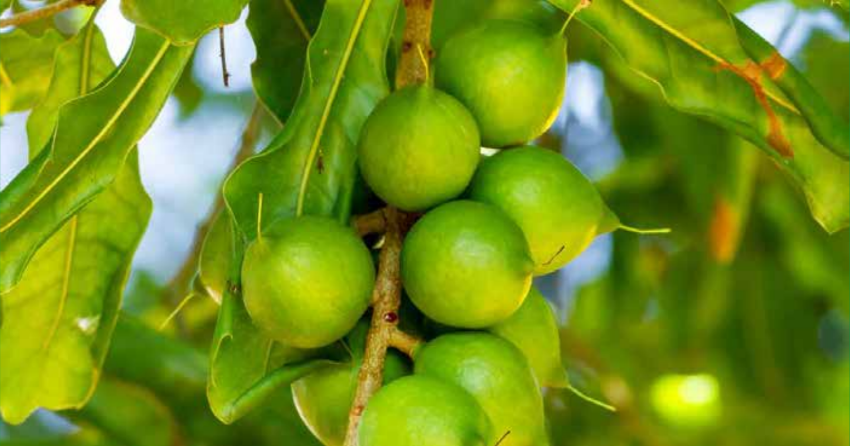
The nature of the Kenyan macadamia sub sector, is such that it demands a signicant level of professional skill amongst growers, processors and marketers. The macadamia industry contributes signicantly to the Kenyan economy in providing local employment and investment as well as domestic and export markets (foreign exchange earnings).
On Maturity, the nut in shell (NIS) is harvested normally by allowing them to fall off the tree. They are then dehusked at which level, the moisture content of up to 30%.
NIS delivered at our factory is checked and quality assessed. Sampling is done on all the bags delivered, floating in water after sizing is done. Our tolerance parameters for acceptance of NIS for our processes are :
| Good Nuts 70% | Mouldy Nuts <5% | Immatures <10% | Insect Damage <10% | Moisture <30% |
| Undersize NIS (<18mm) <5% | ||||
Once a consignment of NIS is within this parameters, it is cleaned and loaded into our driers. We have a drying capacity of 300MT at any one time. We intend to increase this capacity to 600MT in the next one year.
Before processing, the NIS are carefully dried taking up to two weeks to attain the moisture levels to 1.5%. At this level, the kernel would have shrunk from off the shell therefore allowing the shells to be cracked without damaging the kernel.
Cracking & Sorting
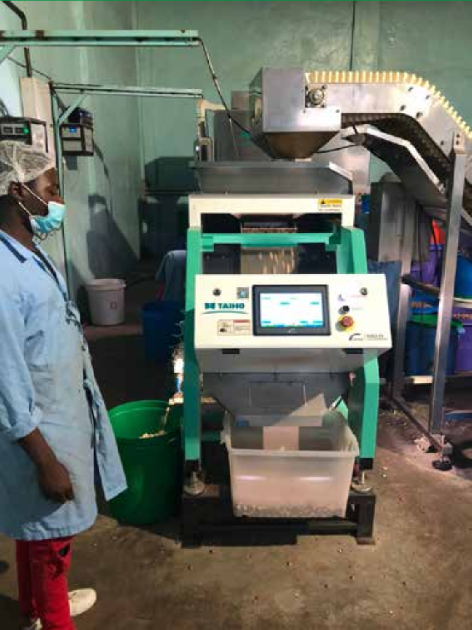
Processing of macadamia nuts began slowly with early enthusiasts cracking the nuts by hand. Modern machines have been developed to crack the tough shell of the macadamia without damaging the precious kernel within. These machines have either a xed blade and cutting blade, or a combination of rollers and a base plate to compress the shell. At Wish Kenya, we us a state-of-the-art cracking unit with a capacity of 2T/per hour. Once the nuts are cracked, they are then passed on to another color sorter to separate the shells from the kernel.
A second state-of-the-art colour sorter is in place to sort the kernel from the discolored nuts before they hand sorting is done to ensure 100% separation of good kernel from insect damage and immature ones. This color sorter constitutes an imperative part to the process in assuring the final quality of Wish Kenya products enhancing our competitive advantage both in the local and international market.
After sorting, the kernels are sized (graded according to size) having assured a moisture content of less 1.5%. They are then filled into laminated aluminum foils, weighed in 25lbs(11.34kgs) then nitrogen ushed vacuum sealed and packed into cartons or according to customer preferences. We do employ very strict quality control measure that assures of fresh premium quality macadamia nuts to our customers. The resulting grades are:
Growing Macadamias
| STYLE | SCREEN SIZE | DESCRIPTION |
| 1L | 17-20MM | 90% Premium large whole Kernel |
| 1SS | 14-17MM | 90% Premium large whole Kernel |
| 2L | 13-20MM | Premium 50/50 wholes and Halves |
| 2S | 13-17MM | Premium 50/50 wholes and Halves |
| 4L | 13MM+ | 90% Premium Halves |
| 4S | 11-13MM | 90% Premium Halves |
| 5 | 8MM+ | Premium Natural chip |
| 6 | 6-8MM | Premium Natural chip |
| 7 | 5-6MM | Premium Natural chip |
| Commercial Wholes | Colored Wholes | |
| Commercial Halves | Colored Halves | |
| NOTES | ||
| Whole Kernel | Whole Kernels are kernels which are not split or separated into halves, with not more than 25% of the kernel missing provided that the kernel contour is not materially affected by the missing portion | |
| Sizing | Size refers to “passing over the smaller diameter hole” and “falling through the greater diameter hole” on the size tables | |
| Laboratory | Laboratory tests are supplied with each distinct batch of production. Tests cover chemical and microbiological thresholds. | |
Nutritional Facts
Nutritional Facts and Health Benefits of Macadamia Nuts
Macadamia nuts are a delightful nut with delicate avour and crunchy texture. It is considered the world’s nest nut. A balanced diet containing macadamia nut contributes to sound health, long life and promotes good health, longevity and checks degenerative diseases. There is evidence that they have a positive effect on many aspects of our health and they are full of important nutrients including monounsaturated fats, proteins, dietary ber, minerals, vitamins, and phytochemicals.
Nutritionists, medical researchers and food scientists are undertaking ongoing research into nutritional and health benets of macadamias which means available information is being updated.
Summary of Health Benefits
- Macadamias contain no cholesterol as they are natural plant food
- Macadamias are not genetically modified and only contain natural genes.
- Research* has shown that macadamias can help lower blood cholesterol levels.
- Research* has shown that macadamias may reduce the incidence of heart disease.
- High in fiber.
- Very high proportion of monounsaturated fat.
- Contain vitamins, minerals and protein essential in a healthy diet.
- AND they taste great, too!
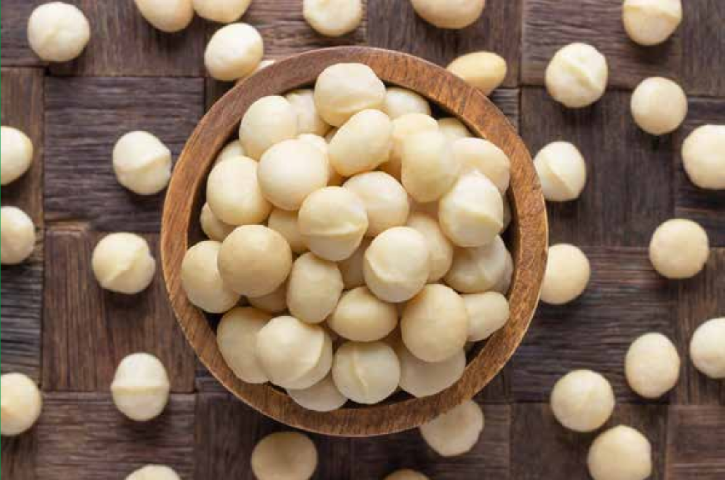
Nutritional Benefits
As macadamias are a natural product their composition may vary due to the growing district, variety, cultural procedures and growing season. The composition of macadamias typically contain the following:
| Composition of 100g dried macadamia nuts | |
| Protein | 7.91g |
| Total Fat | 75.77g |
| Carbohydrates | 13.8g |
| Fibre | 5.2gm |
| Thiamin | 0.350mg |
| Riboflavin | 0.162g |
| Niacin | 2.473mg |
| Calcium | 85mg |
| Iron | 3.69mg |
| Magnesium | 130mg |
| Phosphorus | 188mg |
| Potassium | 368.0mg |
| Sodium | 5.0mg |
| Source: www.nal.usda.gov/fnic/foodcomp/cgi-bin/list-nut Above relates to edible portion only Variety and seasonal conditions may cause minor variations in above values. | |
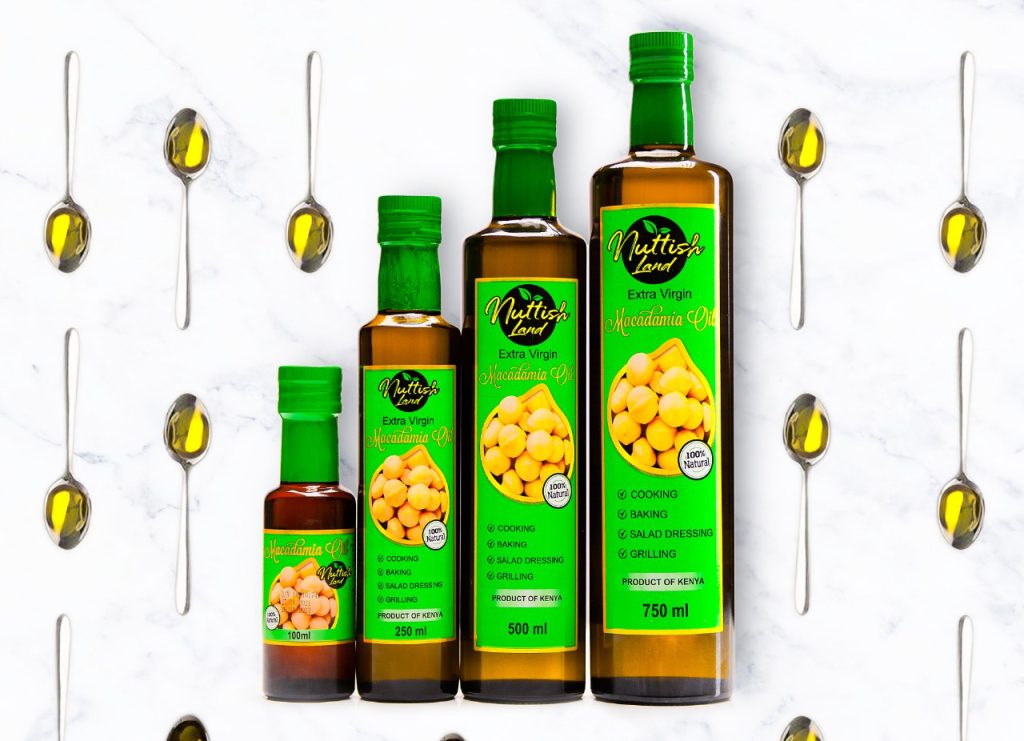
Wish packages oil in 100ml, 250ml, 500 and 750ml bottles. Our nuts are vacuum packed in 200g jar (premium), 50g and 100g packets.
Macadamia nuts are an unexpected new source of exceptionally healthy salad and cooking oil. Though we have known for years that Macadamia nuts are very healthy and delicious to eat, recent scientic evidence revealed that Macadamia oil offers a bounty of special benets for your health. The oil in macadamias is largely monounsaturated which is often described as the “good oil”.
Comparison on dietary fats and oils
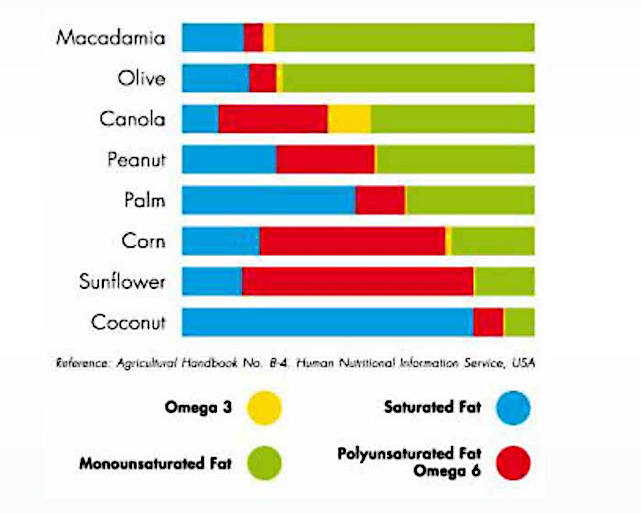
Interesting Facts About Macadamia Oil
COOKING
- The fat in Macadamia oil is 80% monounsaturated (the most beneficial for your health) the highest percentage amongst cooking oils.
- Macadamia oil is the lowest of all culinary oils in Omega 6 fat.
- Macadamia oil retains a very high smoke point of 234°C, and is ideal for stir frying, sautéing and salad dressings.
- Macadamia oil is very stable in use and also provides long shelf-life.
ENRICHING
- Macadamia oil is high in palmitoleic acid a monounsaturated fatty acid that does not occur in any other plant oil yet is found in the human skin’s sebum. This makes it an ideal, nourishing application for normal to dry complexions or those that are continually exposed to the harsh elements.
- Macadamia oil makes a wonderful, emollient addition to a therapeutic bath.
- Macadamia oil can be used in skin or facial oils, massage oils or as a direct application to parched, mature and dry skin conditions.
Macadamia oil is rich in fatty acids and potassium. Macadamia oil is popular in its pure, cold-pressed extra virgin macadamia nut oil form containing highest levels of monosaturated fats (84%) among all oil foods is even higher than Olive oil.
Properties
- Almost 80% of its fatty acids (FAs) are monounsaturated, mostly oleic (C18:1; ~60%) and palmitoleic acids (C16:1; ~20%).[8] Other FAs identified in macadamia nuts include: lauric (C12:0), myristic (C14:0), palmitic (C16:0), stearic (C18:0), arachidic (C20:0), behenic (C22:0), lignoceric (C24:0), eicosenoic (C20:1), erucic (C22:1), linoleic (C18:2), and linolenic (C18:3) acids.
- Its fatty acids prole helps to improves blood lipid proles and decreases inflammation and oxidative stress, thus contributing to lowering body mass and generally reducing cardiovascular disease risk factors. Biological-clinical studies involving animals and humans have shown that the intake of macadamia nuts helps to lower Triglycerides(TC) and Low Density Lipoprotein (LDL) levels
- Macadamia nut oil is also high in phytosterols, which are the building blocks of our cellular membrane and structure. Phytosterols work the same way that cholesterol does in our skin, which is one of the reasons why macadamia nut oil is known to help repair the skin’s barrier function.
Each Macadamia oil drop is rich in essential fatty acids;
- Palmitoleic acid (approximately 18-25 percent), a monounsaturated fatty acid that may have beneficial effects on insulin sensitivity, cholesterol metabolism. which helps to check premature aging;
- Oleic acid (approximately 55-67 percent) a monounsaturated fat that can improve cardiovascular health when used in place of saturated fats or refined carbohydrates and helps in preventing trans-epidermal water loss (TEWL).
- Palmitic acid (approximately 7-9 percent), a saturated fatty acid that may increase LDL cholesterol and have a negative effect on heart health
- Stearic acid (approximately 2-5 percent) a saturated fatty acid that can decrease LDL cholesterol (although not as effectively as unsaturated fats)
- Linoleic acid (approximately 1-4 percent) or omega-6 fatty acids, these polyunsaturated fats are sometimes associated with weight loss, although evidence is lacking
IN THE KITCHEN
- As a salad dressing – For a delicious salad dressing, macadamia oil makes a great base.
- As a marinade Macadamia oil also makes a fantastic base for a full-avoured marinade. With a rich taste that lends itself to marinades and dressings, it’s delicious chilled, and drizzled over a crisp cold salad.
- In a stir fry – A hot wok and macadamia oil is the perfect starting point for your next stir fry.
- As a substitute for butter when baking – Another smart way to use macadamia oil is as a substitute for butter.
- For roasting – Breathing new life into the Sunday roast
- For deep-frying – Macadamia oil is ideal for deep-frying, offering a healthier alternative to other frying oils.
- The smoke point of macadamia oil is 407°F, which is about double the smoke point of olive oil at 207°F. That means it’s a great cooking oil and doesn’t burn as easily. This oil excels
NUTRITION FACTS
One tablespoon of Macadamia oil contains.
- Calories: 120
- Fat: 14g
- Sodium 0mg
- Carbohydrates: 0g
- Fiber: 0g
- Sugars: 0g
- Protein: 0g
Comparison with Virgin Olive oil
| Macadamia | Olive | Benefits | |
| Monosaturated fats | 85% | 76% | Monosaturated fats lower bad cholesterol reducing the chances of a heart attack and stroke |
| Antioxidant Rich Vitamin E | 4 times as much | 76% | This checks the oxidative stress caused by the free radicals in the body, which may have beneficial effects on autoimmune, inflammatory and cancer diseases |
| Smoke point | Between 210ºC – 234ºC | 160ºC | Used for deep frying |
| Shelf Stability & Longevity | Up to five years | 1-2 years | Lasts longer |
Macadamia oil owes its stability mostly to its extremely low omega-6 fatty acid content (the lowest of all traditional cooking oils) and it is perfectly balanced with Omega 3 FAs.
NB: The American Heart Association (AHA) recommends low-fat diets to help lower plasma cholesterol levels, and substitute energy content from saturated fatty acids (SFAs) with
